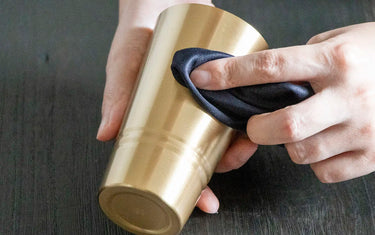The product we used:
Brass is Nice

Brass, known for its warm, golden hue, brings a touch of elegance and durability to kitchenware. This alloy, primarily composed of copper and zinc, not only offers aesthetic appeal with its rich color that deepens over time but also provides excellent workability, allowing it to be crafted into intricate designs or robust kitchen tools. Its malleability means items like cookware, utensils, and decorative pieces can maintain fine details or be shaped for ergonomic comfort. However, brass’s allure goes beyond looks; it conducts heat well, making it an excellent choice for cookware where even heating is beneficial, and its antimicrobial properties make it hygienic for food preparation areas.
Brass needs special care

Recently, brass items like tableware, cutlery, and accessories have become more accessible, with many now available for easy purchase through online shopping, making brass products a more familiar presence.
Brass is an alloy of copper and zinc, where the zinc content is 20% or more. It’s a metal known for its balance of flexibility and strength, but it can tarnish or develop verdigris when exposed to air or moisture.
Tarnishing occurs when copper oxidizes, forming an oxide film that turns the surface a blackish color. This patina brings softness and character to brass’s shine, which many enjoy as an aging process or patina.
Verdigris, a type of rust, forms when copper reacts with salt or moisture. It’s particularly common in accessories where skin contact is prolonged, exposing the brass to sweat and salt.
The rate at which tarnish and verdigris occur varies with how brass is handled. Knowing how to care for and treat brass can allow you to enjoy its changes while using it for a long time.
Care Tips
Using Brass-Specific Cleaners

Use cleaners specifically designed for brass or copper to polish it. These cleaners are available at home centers or online, making it easy to clean brass with just a light scrub.
Using Baking Soda

Baking soda, widely used in eco-friendly cleaners and baking, is also effective against tarnishing on metals including brass.
Mix baking soda with water in a 2:1 ratio to form a paste, and rub it onto brass with your finger or a cloth. As you rub, the paste turns grey, indicating that dirt is being removed.
For stubborn or hard-to-reach areas, using a cotton swab or toothbrush is recommended. Rub gently to avoid scratching the surface.
Using Vinegar

If you don’t have baking soda at home, vinegar can also remove dirt.
Simply fill a container with enough vinegar to submerge the brass item, let it soak for about 3 minutes, rinse off the dirt with water, and wipe dry with a soft cloth.
Substitutes with Citric Acid or Lemon Juice

For those who dislike the smell of vinegar, citric acid or lemon juice can be used without the odor.
Citric acid, derived from sweet potato starch, is a mildly acidic powder often used as an eco-friendly cleaner like baking soda. Its mild acidity makes it effective against alkaline dirt, ideal for brass care.
Dissolve a teaspoon of citric acid in 100ml of water, then clean as you would with vinegar.
For stubborn dirt, mix citric acid with an equal amount of baking soda; the resulting carbon dioxide bubbles from the neutralization reaction help lift dirt, making it especially useful for heavily tarnished brass.
Long-term storage

Brass items that you don’t plan on using frequently or use for decoration can be stored in a plastic bag to prevent exposure to moisture. Make sure any items you place in the bag are dry before sealing it.
Beautiful Brass
Now you can buy beautiful brass kitchenware knowing you’ll be able to enjoy its rich, warm shine even longer. Leave a note in the comments if you have any other tips for taking care of and preserving brass!














